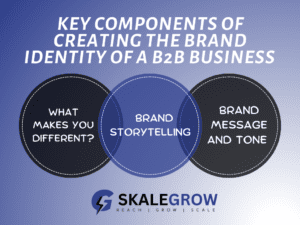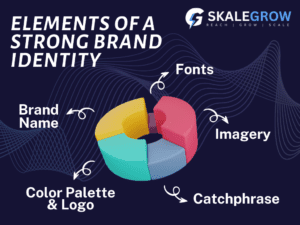In the B2C world, catchy jingles and mascots can propel a brand to instant recognition. Wondering if you can you do the same for your B2B brand to succeed? In most cases, that might not go well with your brand voice. B2B branding requires a different approach.
Instead of going with flashy ads, you need to go for building trust and showcasing your expertise. This is only possible through consistent efforts over time. Your brand has to have a unique voice that connects with your ICP (Ideal Customer Profile).
In this blog post, we will discuss everything you need to know when it comes to building a long lasting B2B brand in addition learning how to build a memorable brand awareness campaign. Let’s get started.
Key components of creating the brand identity for a B2B business
Before building and implementing a brand awareness campaign, it’s imperative to create your own brand identity. So, let’s first learn the steps involved in it.

1. What makes you different?
Most B2B markets are saturated, and standing out is not easy. Here’s how to identify your unique selling proposition (USP):
- Analyze your services: Ask yourself these questions: What features and functionalities differentiate your product or service from competitors? Do you offer superior customer support, a faster implementation process, or unmatched security features?
- Focus on intangibles: Sometimes, it’s the “why” behind your solution that sets you apart. Do you have a strong focus on innovation? Do you prioritize sustainability practices? Highlight these values in your messaging.
- Customer testimonials: Existing customer feedback is a goldmine. What do they value most about working with you? Use their positive experiences to underscore your competitive edge.
By highlighting your differentiators, you can create a compelling narrative that resonates with your target audience, thereby helping you to become the ‘purple cow’.
2. Brand storytelling
People connect with stories. Storytelling can help create a narrative around your brand. Make sure that it goes beyond just features and benefits.
- The “hero’s journey”: Just like a testimonial, showcase how your solutions helped customers overcome their challenges and achieve success.
- Human element: People love the human element. So don’t just talk about technology or processes. For example, showcase how your B2B brand impacts real people, their businesses, and their lives.
- Emotional connection: B2B purchases are driven by human emotions like trust and security. You can use your testimonials here to tap into these emotions.
With the help of storytelling, you will be able to build a stronger emotional connection with your target audience and make your brand more memorable.
3. Brand message and tone
Your brand message summarizes your core value proposition, while your tone defines how you communicate that message.
- Brand Message: This is your elevator pitch. It should clearly articulate what your brand offers and the value it delivers.
- Brand Tone: Is your voice professional and authoritative? Or is it casual and approachable? Your tone needs to align with your overall brand identity and resonate with your target audience.
Here’s how you can refine your message and tone:
- Have clarity: You need to use concise and clear language, so that it is easy to understand. Avoid too much jargon that might alienate your audience.
- Benefits and benefits: Don’t limit yourself by just talking about the features. You can explain how your solutions benefit your customers and fulfill their specific needs.
- Consistency: Try to keep your message and tone consistent across all communication channels. Let it be your website, emails, or social media.
This will help your brand resonate with the target audience and leave a positive impression.
To learn more on how to test your B2B brand message in real-world with your audience: 7 Powerful Ways To Test B2B Messaging
Elements of a strong B2B brand identity
A B2B brand’s identity is the sum of all its visual and verbal elements. It’s what the audience will see, hear, and experience. A strong brand identity can help you gain recognition and trust. Here are the key brand identity elements to consider:

- Brand Name: This is your first impression, so make it count! Choose a name that’s easy to remember, pronounce, and reflects what you do.
- Logo: Your logo is your visual calling card. It should be simple, recognizable, and look good everywhere, from your website to your business card.
- Color Palette: Colors have a big impact on how people perceive your brand. Choose colors that align with your personality and resonate with your target audience.
- Fonts: Fonts can say a lot about your brand. Want to project professionalism? Go for something clean and classic. Feeling creative? Explore some stylish options. Just remember, your fonts should complement your logo and overall tone.
- Imagery: The pictures you use in your marketing materials matter. Choose high-quality visuals that are consistent with your brand aesthetic.
- Catchphrase (optional): A catchy tagline can be a memorable way to sum up your brand essence.
You need all these elements to come together to create a strong and recognizable brand that sets you apart from the competition.
How to Implement a B2B Brand Awareness Campaign
Let’s say you’ve figured out what makes your B2B brand stand out, created a story that resonates with your audience, and even nailed your visual identity. Now what? It’s time to put it all together and implement a B2B brand awareness campaign! Here’s your step-by-step guide for it:
1. Know Your Goals:
- Before diving in, be clear on what you want to achieve. Do you want more website traffic, a buzzing social media community, or simply to get your name out there?
- Set SMART (Specific, Measurable, Achievable, Realistic, and Timebound) goals – milestones you can track to see if your campaign is working its magic.
2. Create Your Strategy:
- Who are you trying to reach? Think about your ideal B2B customer and tailor your approach accordingly.
- Then, pick the tactics that best suit your goals and resources. This might involve content marketing (think blog posts or videos), building a strong social media presence, or partnering with industry influencers.
- Finally, put together a content calendar – a roadmap for what kind of content you’ll create, where you’ll share it, and how often.
3. Content Creation is Key:
- Your B2B brand needs high-quality content that grabs your audience’s attention and speaks to their specific needs and challenges.
- Maybe try to mix things up with blog posts, infographics, videos, case studies, and white papers – informative content that shows your expertise.
- Don’t forget about search engines – optimize your content so that potential customers can easily find you online.
4. Make use of Multiple Channels:
- Instead of promoting your B2B brand on a single channel, go for multiple ones. For example, adopt an omnichannel approach by leveraging your website, social media platforms, email marketing campaigns, and industry publications.
- You can also partner with relevant influencers in your niche to expand your reach by gaining access to their audience.
5. Paid Advertising for Targeted Reach:
- Consider allocating a portion of your budget to paid advertising on platforms like LinkedIn and Google.
- This will allow you to make your targeting laser sharp.
6. Integrate Public Relations Efforts:
- You need to develop press releases and media kits to generate positive media coverage and industry recognition.
- Building relationships with journalists in your industry can help you a lot. You can pitch newsworthy stories that will excite their readers who could be your potential customers.
7. Employee Advocacy:
- Push your employees to become your brand ambassadors. Encourage them to share company content on their social media channels and participate in relevant industry conversations.
- Develop internal communication programs to keep employees informed about brand initiatives and encourage them to highlight their company’s achievements and capabilities.
8. Continuously Monitor and Measure:
- Track key metrics relevant to your campaign goals (e.g., website traffic, social media engagement, brand mentions).
- Use website analytics tools and social media insights dashboards to monitor campaign performance.
- Track the data regularly and adapt your strategy for better results.
9. Adopt a Long-Term Mindset:
- Keep in mind that building brand awareness is an ongoing process, so don’t expect overnight results.
- You’ll have to maintain consistent messaging and tone across various platforms and channels. This over time will anchor a strong brand identity and recall in the minds of your ideal customers.
- Make sure to nurture relationships with potential customers by providing valuable content and engaging interactions.
Keep these points in note and you will be able to build a successful B2B brand awareness campaign that positions your company for long-term growth and industry recognition.
Read more about staying on track in the B2B brand development journey: The 6 stages of brand development journey
Conclusion
Selling to a B2B audience can be complex as it involves multiple decision-makers and a need for long-term value. An efficient brand awareness campaign helps to gain trust early on, making sure that your B2B brand is top-of-mind when it is time to make a purchase decision.
Skalegrow can help! We specialize in helping B2B businesses elevate their brand presence through methods like content marketing, demand generation, social media marketing, and more. Talk to us today to learn how we can transform your business into a globally recognizable B2B brand.


